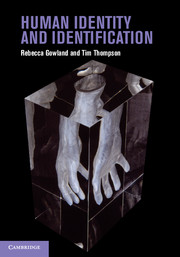8 - Conclusions
identity and identification
Published online by Cambridge University Press: 05 February 2013
Summary
The body was never a free gift; it gives temporary shelter to our aspirations on a finite lease.
(Rifkin et al., 2006: 7)This book has endeavoured to discuss the relationship between the biological and social aspects of our identity and mechanisms of bodily identification. A discursive framework in Chapters 1 and 2 was followed by the dissection of different layers of the body in Chapters 3 to 6, culminating in an examination of body modification in Chapter 7. In each of these chapters, we examined just a few of the multitude of ways in which the biological expression of our corporeal realities is mediated through our social environments. Each layer of the body has been discussed within the context of its specific relationship with body identity and identification, but a number of themes permeate throughout the book and we will draw this volume to a close with an examination of them.
The construction of identity and identification
The construction of identity is complex, multidimensional, sometimes passive, sometimes active, relational and above all body-mediated whether through individual agency or through the body’s capacity to respond dynamically and absorb the by-products of the social fabric. Identity as a concept is difficult to pin down, and teasing out the individual facets of a person’s identity (e.g. gender, ethnicity) is harder still, because in essence they are interwoven both biologically and socially. Constructions of masculinity, for example, depend on age and ethnic norms, and each of these facets have biological repercussions on both a macro and micro scale across the bodily tissues. Identification scientists are only just starting to address identity as a social orchestration rather than as a series of easily definable biological categories. There is a clear disconnect between the way in which a forensic practitioner may define identity, compared to, for example, a sociologist.
- Type
- Chapter
- Information
- Human Identity and Identification , pp. 175 - 183Publisher: Cambridge University PressPrint publication year: 2013



